fuel MITSUBISHI OUTLANDER PHEV 2018 Owner's Manual (in English)
[x] Cancel search | Manufacturer: MITSUBISHI, Model Year: 2018, Model line: OUTLANDER PHEV, Model: MITSUBISHI OUTLANDER PHEV 2018Pages: 538, PDF Size: 25.01 MB
Page 2 of 538
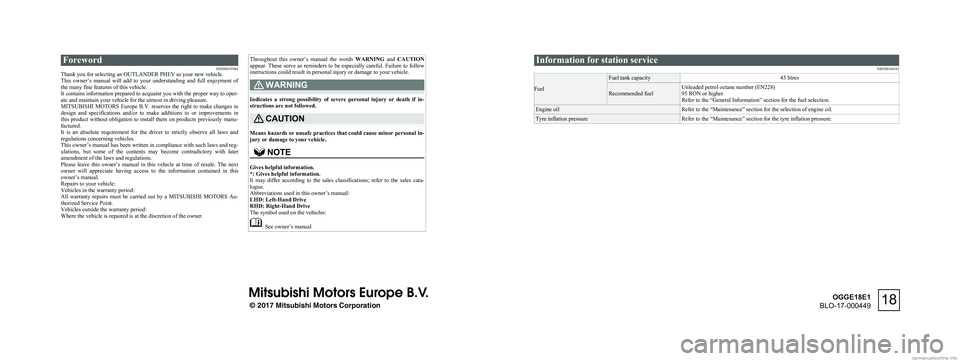
ForewordE09200107064
Thank you for selecting an OUTLANDER PHEV as your new vehicle.
This owner’s manual will add to your understanding and full enjoyment of
the many fine features of this vehicle.
It contains information prepared to acquaint you with the proper way to oper-
ate and maintain your vehicle for the utmost in driving pleasure.
MITSUBISHI MOTORS Europe B.V. reserves the right to make changes in
design and specifications and/or to make additions to or improvements in
this product without obligation to install them on products previously manu- factured.
It is an absolute requirement for the driver to strictly observe all laws and
regulations concerning vehicles.
This owner’s manual has been written in compliance with such laws and reg- ulations, but some of the contents may become contradictory with later amendment of the laws and regulations.
Please leave this owner’s manual in this vehicle at time of resale. The next
owner will appreciate having access to the information contained in this
owner’s manual.
Repairs to your vehicle:
Vehicles in the warranty period:
All warranty repairs must be carried out by a MITSUBISHI MOTORS Au-
thorized Service Point.
Vehicles outside the warranty period:
Where the vehicle is repaired is at the discretion of the owner.Throughout this owner’s manual the words WARNING and CAUTION
appear. These serve as reminders to be especially careful. Failure to follow
instructions could result in personal injury or damage to your vehicle.WARNING
Indicates a strong possibility of severe personal injury or death if in-
structions are not followed.
CAUTION
Means hazards or unsafe practices that could cause minor personal in- jury or damage to your vehicle.
NOTE
Gives helpful information.
*: Gives helpful information.
It may differ according to the sales classifications; refer to the sales cata- logue.
Abbreviations used in this owner’s manual: LHD: Left-Hand Drive
RHD: Right-Hand Drive
The symbol used on the vehicles:
: See owner’s manual
Information for station service
E09300104543
Fuel
Fuel tank capacity45 litresRecommended fuelUnleaded petrol octane number (EN228)
95 RON or higher
Refer to the “General Information” section for the fuel selection.Engine oilRefer to the “Maintenance” section for the selection of engine oil.Tyre inflation pressureRefer to the “Maintenance” section for the tyre inflation pressure.
© 2017 Mitsubishi Motors Corporation18
OGGE18E1
BLO-17-000449
Page 6 of 538
![MITSUBISHI OUTLANDER PHEV 2018 Owners Manual (in English) 1. Multi Around Monitor* p. 7-106Audio* p. 8-13
[For DISPLAY AUDIO, Smartphone Link Display Audio and
MITSUBISHI Multi Communication System (MMCS), refer to
the separate owner’s manual.]
2. Hazard w MITSUBISHI OUTLANDER PHEV 2018 Owners Manual (in English) 1. Multi Around Monitor* p. 7-106Audio* p. 8-13
[For DISPLAY AUDIO, Smartphone Link Display Audio and
MITSUBISHI Multi Communication System (MMCS), refer to
the separate owner’s manual.]
2. Hazard w](/img/19/34890/w960_34890-5.png)
1. Multi Around Monitor* p. 7-106Audio* p. 8-13
[For DISPLAY AUDIO, Smartphone Link Display Audio and
MITSUBISHI Multi Communication System (MMCS), refer to
the separate owner’s manual.]
2. Hazard warning flasher switch p. 6-60
3. ECO mode switch p. 6-61
4. Front passenger’s airbag indicator p. 5-29
5. Passenger’s ventilators p. 8-02
6. Accessory socket* p. 8-74 Cigarette lighter* p. 8-73
7. Electric tailgate power switch* p. 4-20
8. Key slot p. 7-15
9. 220-240 V AC power supply switch* p. 8-75
10. Blind Spot Warning (BSW) switch* p. 7-79
11. Heated steering wheel switch* p. 6-69
12. Heated windscreen switch* p. 6-68
13. Cup holder p. 8-82
14. Selector lever (Joystick type) p. 7-16
15. 220-240 V AC power supply* p. 8-75
16. Floor console box p. 8-81 Arm rest
Accessory socket p. 8-74
USB input terminal p. 8-69
17. Fuel tank filler door release lever p. 2-14
18. Bonnet release lever p. 11-04
19. Rear window demister switch p. 6-67 Wiper de-icer switch* p. 6-67
20. Air conditioner p. 8-04
21. Seat belt reminder p. 5-11
Instruments and controls
1-04OGGE18E1Overview1LHD
Page 7 of 538
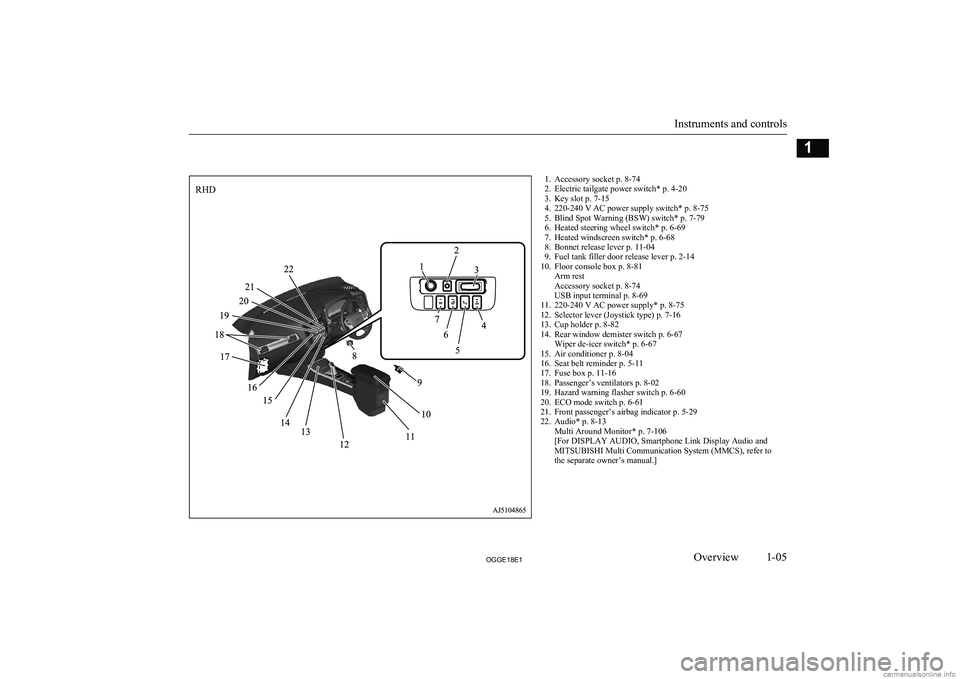
1. Accessory socket p. 8-74
2. Electric tailgate power switch* p. 4-20
3. Key slot p. 7-15
4. 220-240 V AC power supply switch* p. 8-75
5. Blind Spot Warning (BSW) switch* p. 7-79
6. Heated steering wheel switch* p. 6-69
7. Heated windscreen switch* p. 6-68
8. Bonnet release lever p. 11-04
9. Fuel tank filler door release lever p. 2-14
10. Floor console box p. 8-81 Arm rest
Accessory socket p. 8-74
USB input terminal p. 8-69
11. 220-240 V AC power supply* p. 8-75
12. Selector lever (Joystick type) p. 7-16
13. Cup holder p. 8-82
14. Rear window demister switch p. 6-67 Wiper de-icer switch* p. 6-67
15. Air conditioner p. 8-04
16. Seat belt reminder p. 5-11
17. Fuse box p. 11-16
18. Passenger’s ventilators p. 8-02
19. Hazard warning flasher switch p. 6-60
20. ECO mode switch p. 6-61
21. Front passenger’s airbag indicator p. 5-29
22. Audio* p. 8-13 Multi Around Monitor* p. 7-106
[For DISPLAY AUDIO, Smartphone Link Display Audio and
MITSUBISHI Multi Communication System (MMCS), refer to
the separate owner’s manual.]
Instruments and controls
1-05OGGE18E1Overview1RHD
Page 15 of 538
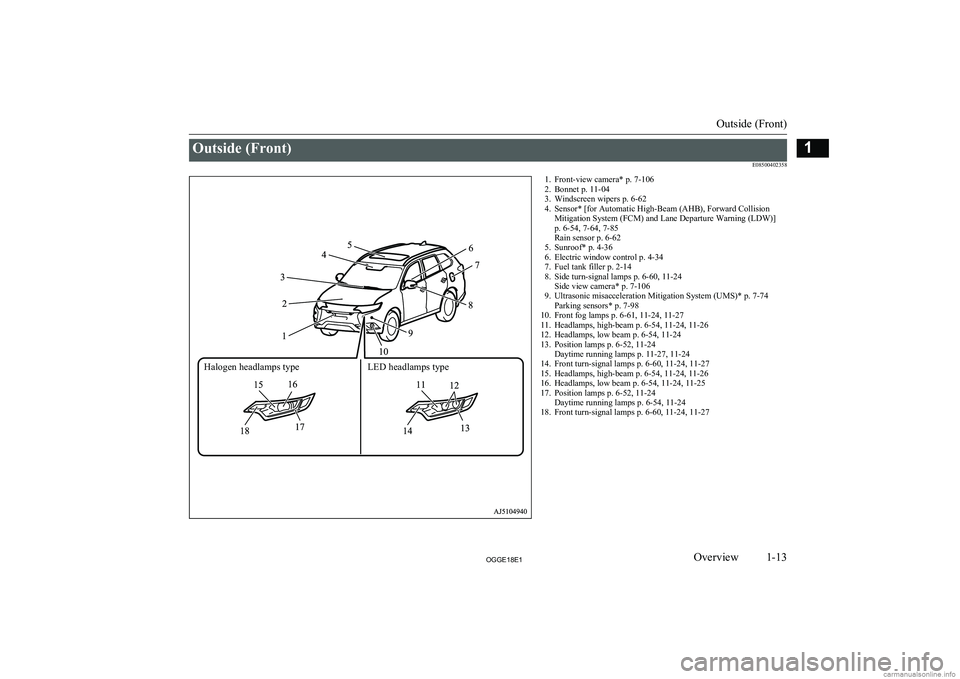
Outside (Front)E085004023581. Front-view camera* p. 7-1062. Bonnet p. 11-04
3. Windscreen wipers p. 6-62
4. Sensor* [for Automatic High-Beam (AHB), Forward Collision Mitigation System (FCM) and Lane Departure Warning (LDW)]
p. 6-54, 7-64, 7-85
Rain sensor p. 6-62
5. Sunroof* p. 4-36
6. Electric window control p. 4-34
7. Fuel tank filler p. 2-14
8. Side turn-signal lamps p. 6-60, 11-24 Side view camera* p. 7-106
9. Ultrasonic misacceleration Mitigation System (UMS)* p. 7-74 Parking sensors* p. 7-98
10. Front fog lamps p. 6-61, 11-24, 11-27
11. Headlamps, high-beam p. 6-54, 11-24, 11-26
12. Headlamps, low beam p. 6-54, 11-24
13. Position lamps p. 6-52, 11-24 Daytime running lamps p. 11-27, 11-24
14. Front turn-signal lamps p. 6-60, 11-24, 11-27
15. Headlamps, high-beam p. 6-54, 11-24, 11-26
16. Headlamps, low beam p. 6-54, 11-24, 11-25
17. Position lamps p. 6-52, 11-24 Daytime running lamps p. 6-54, 11-24
18. Front turn-signal lamps p. 6-60, 11-24, 11-27
Outside (Front)
1-13OGGE18E1Overview1Halogen headlamps type LED headlamps type
Page 20 of 538
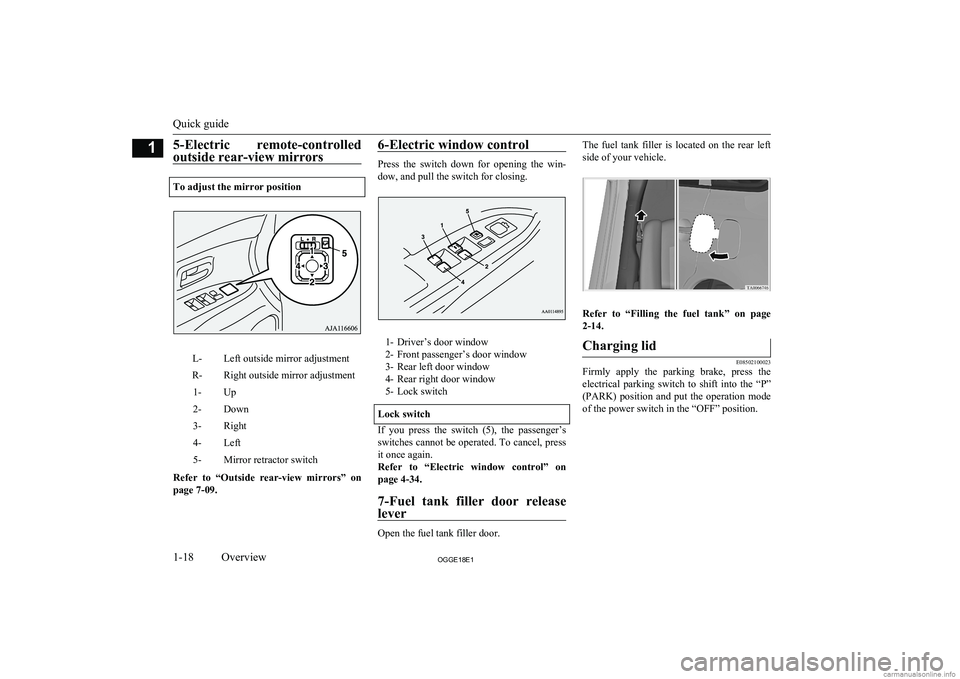
5-Electric remote-controlledoutside rear-view mirrors
To adjust the mirror position
L-Left outside mirror adjustmentR-Right outside mirror adjustment1-Up2-Down3-Right4-Left5-Mirror retractor switch
Refer to “Outside rear-view mirrors” on
page 7-09.
6-Electric window control
Press the switch down for opening the win-
dow, and pull the switch for closing.
1- Driver’s door window
2- Front passenger’s door window
3- Rear left door window
4- Rear right door window
5- Lock switch
Lock switch
If you press the switch (5), the passenger’s switches cannot be operated. To cancel, press
it once again.
Refer to “Electric window control” on
page 4-34.
7-Fuel tank filler door release
lever
Open the fuel tank filler door.
The fuel tank filler is located on the rear left
side of your vehicle.
Refer to “Filling the fuel tank” on page 2-14.
Charging lid
E08502100023
Firmly apply the parking brake, press the electrical parking switch to shift into the “P”
(PARK) position and put the operation mode of the power switch in the “OFF” position.
Quick guide
1-18OGGE18E1Overview1
Page 22 of 538
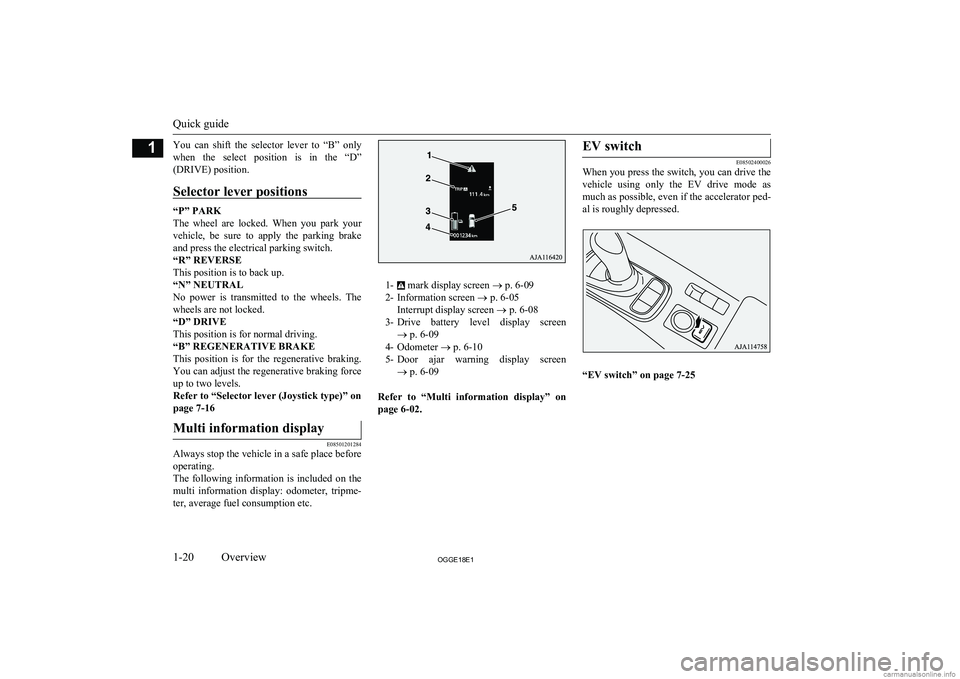
You can shift the selector lever to “B” onlywhen the select position is in the “D”
(DRIVE) position.
Selector lever positions
“P” PARK
The wheel are locked. When you park your
vehicle, be sure to apply the parking brake and press the electrical parking switch.
“R” REVERSE
This position is to back up.
“N” NEUTRAL
No power is transmitted to the wheels. The wheels are not locked.
“D” DRIVE
This position is for normal driving.
“B” REGENERATIVE BRAKE
This position is for the regenerative braking.
You can adjust the regenerative braking force up to two levels.
Refer to “Selector lever (Joystick type)” on
page 7-16
Multi information display
E08501201284
Always stop the vehicle in a safe place before operating.
The following information is included on the multi information display: odometer, tripme-
ter, average fuel consumption etc.
1- mark display screen ® p. 6-09
2- Information screen ® p. 6-05
Interrupt display screen ® p. 6-08
3- Drive battery level display screen
® p. 6-09
4- Odometer ® p. 6-10
5- Door ajar warning display screen
® p. 6-09
Refer to “Multi information display” on page 6-02.
EV switch
E08502400026
When you press the switch, you can drive the
vehicle using only the EV drive mode as
much as possible, even if the accelerator ped- al is roughly depressed.
“EV switch” on page 7-25
Quick guide
1-20OGGE18E1Overview1
Page 25 of 538
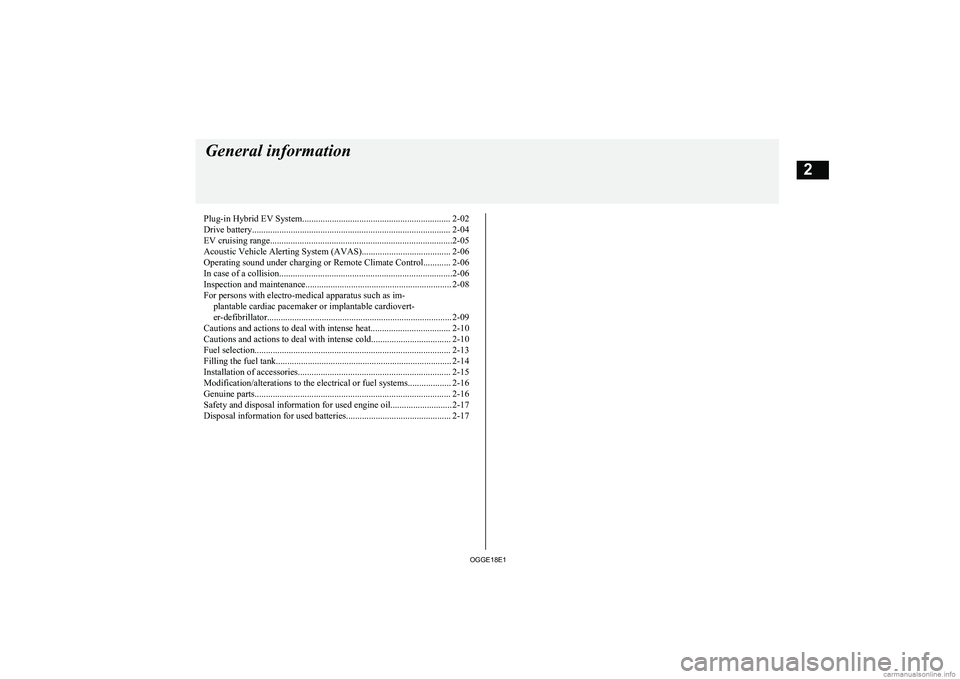
Plug-in Hybrid EV System................................................................. 2-02
Drive battery....................................................................................... 2-04
EV cruising range................................................................................2-05
Acoustic Vehicle Alerting System (AVAS)....................................... 2-06
Operating sound under charging or Remote Climate Control............ 2-06
In case of a collision............................................................................2-06
Inspection and maintenance................................................................ 2-08
For persons with electro-medical apparatus such as im- plantable cardiac pacemaker or implantable cardiovert-
er-defibrillator................................................................................. 2-09
Cautions and actions to deal with intense heat................................... 2-10 Cautions and actions to deal with intense cold................................... 2-10Fuel selection...................................................................................... 2-13Filling the fuel tank............................................................................. 2-14Installation of accessories................................................................... 2-15
Modification/alterations to the electrical or fuel systems................... 2-16
Genuine parts...................................................................................... 2-16 Safety and disposal information for used engine oil........................... 2-17
Disposal information for used batteries.............................................. 2-17General information
OGGE18E12
Page 27 of 538
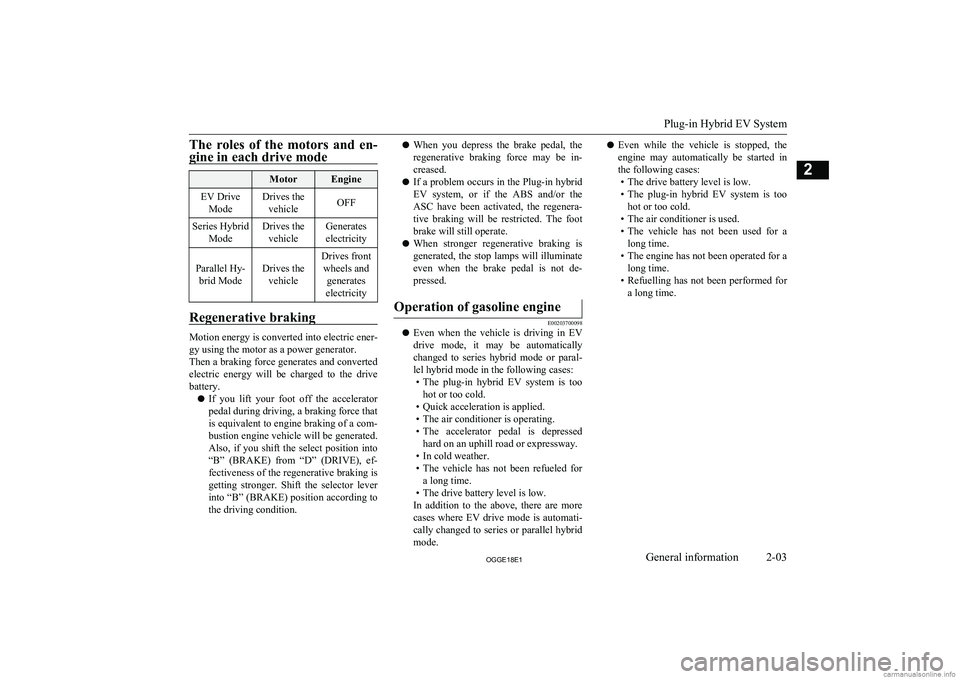
The roles of the motors and en-gine in each drive mode MotorEngineEV Drive ModeDrives thevehicleOFFSeries Hybrid ModeDrives thevehicleGenerates
electricity
Parallel Hy- brid ModeDrives the vehicle
Drives frontwheels and generates
electricity
Regenerative braking
Motion energy is converted into electric ener-
gy using the motor as a power generator.
Then a braking force generates and converted electric energy will be charged to the drive
battery.
l If you lift your foot off the accelerator
pedal during driving, a braking force that
is equivalent to engine braking of a com- bustion engine vehicle will be generated.
Also, if you shift the select position into “B” (BRAKE) from “D” (DRIVE), ef-
fectiveness of the regenerative braking is getting stronger. Shift the selector lever into “B” (BRAKE) position according to
the driving condition.
l When you depress the brake pedal, the
regenerative braking force may be in-creased.
l If a problem occurs in the Plug-in hybrid
EV system, or if the ABS and/or the
ASC have been activated, the regenera- tive braking will be restricted. The foot brake will still operate.
l When stronger regenerative braking is
generated, the stop lamps will illuminate even when the brake pedal is not de- pressed.Operation of gasoline engine
E00203700098
l Even when the vehicle is driving in EV
drive mode, it may be automatically
changed to series hybrid mode or paral-
lel hybrid mode in the following cases: • The plug-in hybrid EV system is too
hot or too cold.
• Quick acceleration is applied.
• The air conditioner is operating.
• The accelerator pedal is depressed
hard on an uphill road or expressway.
• In cold weather.
• The vehicle has not been refueled for
a long time.
• The drive battery level is low.
In addition to the above, there are more
cases where EV drive mode is automati-
cally changed to series or parallel hybrid mode.
l Even while the vehicle is stopped, the
engine may automatically be started in the following cases: • The drive battery level is low.
• The plug-in hybrid EV system is too
hot or too cold.
• The air conditioner is used.
• The vehicle has not been used for a
long time.
• The engine has not been operated for a long time.
• Refuelling has not been performed for
a long time.
Plug-in Hybrid EV System
2-03OGGE18E1General information2
Page 28 of 538
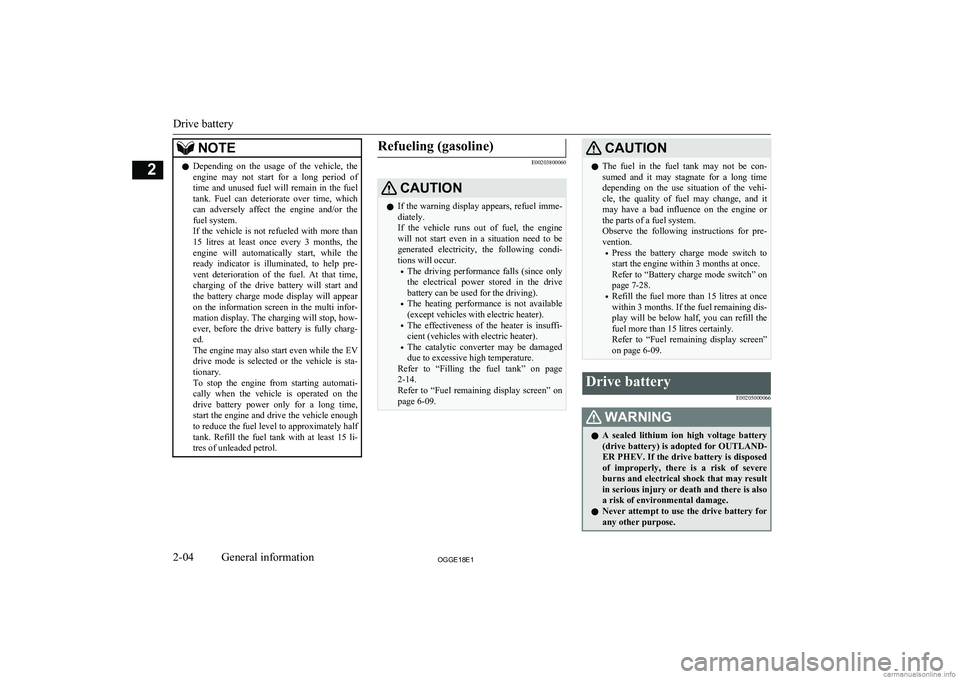
NOTElDepending on the usage of the vehicle, the
engine may not start for a long period of
time and unused fuel will remain in the fuel tank. Fuel can deteriorate over time, which
can adversely affect the engine and/or the
fuel system.
If the vehicle is not refueled with more than
15 litres at least once every 3 months, the engine will automatically start, while the ready indicator is illuminated, to help pre-vent deterioration of the fuel. At that time,
charging of the drive battery will start and the battery charge mode display will appear
on the information screen in the multi infor-
mation display. The charging will stop, how-
ever, before the drive battery is fully charg- ed.
The engine may also start even while the EV drive mode is selected or the vehicle is sta-
tionary.
To stop the engine from starting automati-
cally when the vehicle is operated on the drive battery power only for a long time,start the engine and drive the vehicle enough
to reduce the fuel level to approximately half
tank. Refill the fuel tank with at least 15 li- tres of unleaded petrol.Refueling (gasoline)
E00203800060
CAUTIONl If the warning display appears, refuel imme-
diately.
If the vehicle runs out of fuel, the engine will not start even in a situation need to be
generated electricity, the following condi- tions will occur.
• The driving performance falls (since only
the electrical power stored in the drive battery can be used for the driving).
• The heating performance is not available
(except vehicles with electric heater).
• The effectiveness of the heater is insuffi-
cient (vehicles with electric heater).
• The catalytic converter may be damaged
due to excessive high temperature.
Refer to “Filling the fuel tank” on page
2-14.
Refer to “Fuel remaining display screen” on page 6-09.CAUTIONl The fuel in the fuel tank may not be con-
sumed and it may stagnate for a long time
depending on the use situation of the vehi- cle, the quality of fuel may change, and it
may have a bad influence on the engine or the parts of a fuel system.
Observe the following instructions for pre-
vention.
• Press the battery charge mode switch to
start the engine within 3 months at once.
Refer to “Battery charge mode switch” on page 7-28.
• Refill the fuel more than 15 litres at once
within 3 months. If the fuel remaining dis-
play will be below half, you can refill the
fuel more than 15 litres certainly.
Refer to “Fuel remaining display screen” on page 6-09.Drive battery
E00205000066WARNINGlA sealed lithium ion high voltage battery
(drive battery) is adopted for OUTLAND-
ER PHEV . If the drive battery is disposed
of improperly, there is a risk of severe burns and electrical shock that may resultin serious injury or death and there is also
a risk of environmental damage.
l Never attempt to use the drive battery for
any other purpose.
Drive battery
2-04OGGE18E1General information2
Page 29 of 538
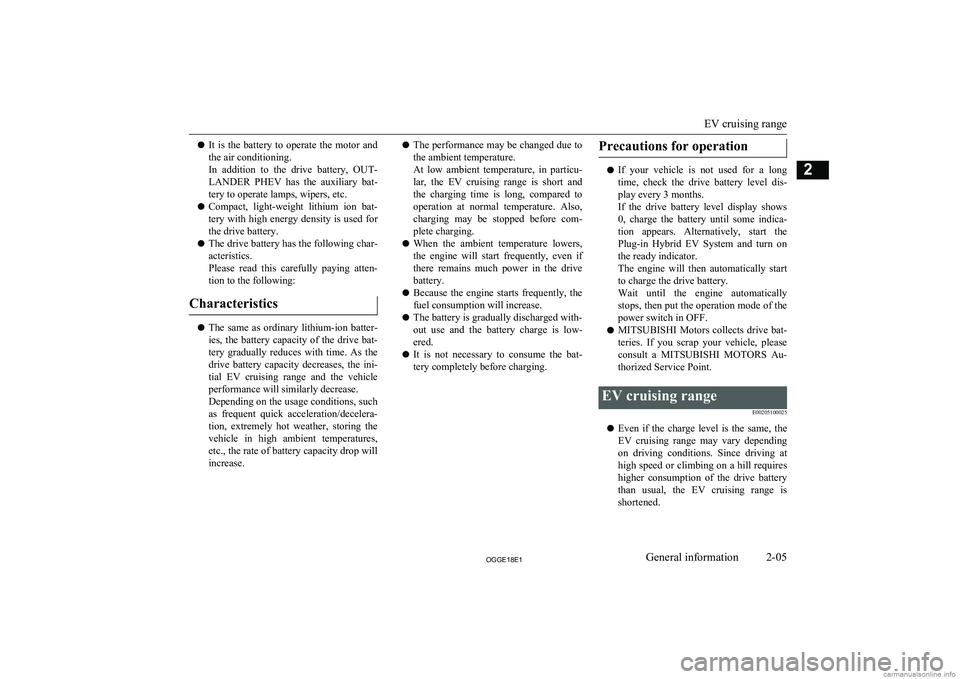
lIt is the battery to operate the motor and
the air conditioning.
In addition to the drive battery, OUT-
LANDER PHEV has the auxiliary bat-
tery to operate lamps, wipers, etc.
l Compact, light-weight lithium ion bat-
tery with high energy density is used for the drive battery.
l The drive battery has the following char-
acteristics.
Please read this carefully paying atten-
tion to the following:
Characteristics
l The same as ordinary lithium-ion batter-
ies, the battery capacity of the drive bat-
tery gradually reduces with time. As the
drive battery capacity decreases, the ini- tial EV cruising range and the vehicle
performance will similarly decrease.
Depending on the usage conditions, such as frequent quick acceleration/decelera- tion, extremely hot weather, storing the
vehicle in high ambient temperatures, etc., the rate of battery capacity drop will
increase.
l The performance may be changed due to
the ambient temperature.
At low ambient temperature, in particu- lar, the EV cruising range is short and
the charging time is long, compared to operation at normal temperature. Also,charging may be stopped before com-
plete charging.
l When the ambient temperature lowers,
the engine will start frequently, even if there remains much power in the drive
battery.
l Because the engine starts frequently, the
fuel consumption will increase.
l The battery is gradually discharged with-
out use and the battery charge is low-
ered.
l It is not necessary to consume the bat-
tery completely before charging.Precautions for operation
l If your vehicle is not used for a long
time, check the drive battery level dis-
play every 3 months.
If the drive battery level display shows
0, charge the battery until some indica- tion appears. Alternatively, start the
Plug-in Hybrid EV System and turn on the ready indicator.
The engine will then automatically start to charge the drive battery.
Wait until the engine automatically
stops, then put the operation mode of the
power switch in OFF.
l MITSUBISHI
Motors collects drive bat-
teries. If you scrap your vehicle, please
consult a MITSUBISHI MOTORS Au-
thorized Service Point.
EV cruising range
E00205100025
lEven if the charge level is the same, the
EV cruising range may vary depending on driving conditions. Since driving at
high speed or climbing on a hill requires higher consumption of the drive batterythan usual, the EV cruising range is shortened.
EV cruising range
2-05OGGE18E1General information2